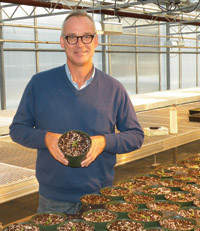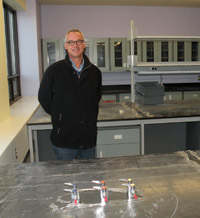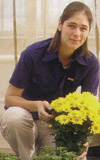
Canadian horticulture is increasingly being squeezed by tight margins
and buffeted about by an ever-changing marketplace. High energy prices
and rising labour costs are also limiting industry expansion plans.
Canadian horticulture is increasingly being squeezed by tight margins and buffeted about by an ever-changing marketplace. High energy prices and rising labour costs are also limiting industry expansion plans.
 |
|
| Dr. Jim Brandle, in a VRIC greenhouse. New benches have recently been installed. Advertisement
|
And this is indeed big business in Canada, with some $5.4-billion in farmgate receipts, about 15 per cent of all agriculture and trailing only grains and cattle in size, according to the Canadian Horticulture Sector 2007 Crop Year Performance Overview by Agriculture and Agri-Food Canada. Some 300,000 people are employed in growing the crops, with a considerable number of spinoff jobs in the agri-food sector, which employs one in seven Canadians.
The key to industry growth, or at least stability, say many pundits, will be through increased research and innovation. And help is on the way.
CENTRE CELEBRATED CENTENNIAL IN 2006
Ontario has a large horticulture sector, and for many years the Vineland Research Centre – located along Lake Ontario and just minutes from St. Catharines – has been a major driver in that growth. The centre celebrated its centennial in 2006.
It’s about to become an even larger industry player.
In August 2006, then Ontario agriculture minister Leona Dombrowsky appointed a committee – the Vineland Renaissance Panel – to examine the revitalization of the centre. Following extensive industry consultations, the panel submitted a 10-year business plan, framed around its vision of Vineland becoming “a world-class research institution and international hub for horticulture and floriculture research, innovation and commercial activity with a focus on grapes, tender fruit, greenhouse floriculture and ornamentals.”
 |
|
| Annual poinsettia trials.
|
The report authors found widespread support in the industry for “the vision of a transformed ‘Vineland’ research centre.” And both senior levels of government, who for a number of years had allowed Vineland’s facilities to fall behind the times, heartily endorsed the report, and pledged generous funding support for the transformation effort.
“Research and innovation are crucial to the future success of Ontario’s agri-food sector,” said Dombrowsky, in commenting on the report. “By making this investment, we are signalling a new day and innovative approaches to capturing new opportunities.”
STRONG BASE OF COLLABORATION AND PARTNERSHIPS WITHIN THE INDUSTRY
Panel member, and local fruit grower, Jamie Warner, reflected the excitement of local hort producers. “Vineland will be revitalized on a strong base of collaboration and partnerships within our industry, with governments at all levels, and with the university and college research communities. At the same time, it will assist local farm families like mine to be on the leading edge in an increasingly competitive environment.”
Heading up the project is Dr. Jim Brandle, chief executive officer with the Vineland Research and Innovation Centre (VRIC). He didn’t hesitate when asked to lead the project and immediately accepted the offer. “It was a chance to do something new. I knew innovation had to happen in a different way, and this would be a totally new model for innovation in agriculture.”
He began working at Vineland in June 2007. Since then, he has spent considerable time consulting with stakeholders and the research community – both here and abroad – on what the new innovation model should look like. He’s also begun to assemble a world-class team of research and commercialization specialists.
Things are now shifting from a startup to an operational phase. There are now 44 people working with VRIC, with employment to grow to more than 80 by 2012.
‘LOOKING FOR CANDIDATES WITH A PIONEERING SPIRIT’
“We’re looking for candidates with a pioneering spirit,” said Dr. Brandle. “This isn’t the place to rest on your laurels. We need people interested in helping create the future.”
Vineland has signed a number of collaboration agreements with other research stations and post-secondary institutions. “Our mission is to create premium innovations, something of high value, something that will grow the industry,” said Dr. Brandle. “We’re looking at things that will make a difference, and by partnering, we can do a lot more.”
There are three core areas of research, with team leaders now in place:
Consumer Insights and Product Innovation – Dr. Isabelle Lesschaeve. This group will lead research initiatives to add margins to horticulture products through consumer research. The outcome of this research will have a major impact on the sensory characteristics (flavour, odour, texture) of horticulture products.
Applied Genomics – Dr. Daryl Somers. This team will provide the link between the genome sciences and plant breeding by translating whole genome sequence information into markers useful for selection of traits related to consumer preference, diseases resistance and yields.
Horticultural Production Systems – Dr. Michael Brownbridge. He brings extensive experience in greenhouse and pest management research, and will lead his group in the field of biocontrol.
 |
|
| Three floors of labs have been reconstructed, with work just finishing up during our mid-January visit.
|
These core areas, explained Dr. Brandle, “are the areas we felt would have the greatest impact” on helping grow the industry.
Consumers interact directly with horticulture. “They may not care what their corn looks like, but they will care about their peaches or flowers.”
Helping the industry reduce its environmental footprint is important. “How do we use less water, less light, less energy, less fertilizer? That’s what we want to find out. It’s all about saving dollars and creating margins.”
Reducing pesticide usage is another goal. The greenhouse vegetable sector has been at the forefront of this trend for many years. “Biological control is such a big part of that industry, but we’ve never had the drivers to spread that to other parts of agriculture. We’re going to show a lot of leadership with this.”
GROWERS WILL ENJOY QUICK ACCESS TO RESEARCH GAINS
Growers will immediately benefit from the research. “We’re ensuring our successes will be quickly going into production,” said Dr. Brandle. “We want these ideas to zoom out of here as fast as possible.”
Work has commenced on revitalizing the facilities. Three floors of labs have already been reconstructed. New benches have been installed in the greenhouses. A new retractable roof greenhouse will be used in the nursery program.
Work is now underway on a site master plan, and a fundraising campaign will be launched once it’s completed. The Ontario government has already committed $12.5-million towards the revitalization project.
In addition to a board of directors, VRIC has a science advisory committee with representation from throughout Canada and from as far away as the Netherlands, Israel, Australia and New Zealand.
There is also a stakeholder advisory committee. Industry input and feedback is essential to the success of the research work. “If your money is here, you’ll want to be here watching your projects evolve.”
‘FRIENDS OF VINELAND’ WILL HAVE A ROLE TO PLAY
Plans also call for a Friends of Vineland community support group of staff alumni, neighbours and others. “There are a lot of activities that go on here that volunteers could help with,” said Dr. Brandle.
VRIC is developing momentum and getting much busier. “There are already days here when the parking lot is full and the meeting rooms are all busy,” he said. “Things are happening.”
Everyone will have a shared vision. Dr. Brandle referred to the oft-quoted story of a visitor to NASA asking a janitor what he did, to which the custodian replied that he was helping to put a man on the moon. “Everyone here will be working to create those big projects that will make a difference (to the industry),” said Dr. Brandle. ■
| Research group is growing
At its inception in 2006, Vineland Research and Innovation Centre (VRIC) was a vision for the future. Today, the centre’s mandate to be an internationally recognized horticulture research and innovation centre of excellence is being realized with a growing team of research and innovation experts. Building on Vineland’s core disciplines of Consumer Insights and Product Innovations, led by Dr. Isabelle Lesschaeve, Applied Genomics, led by Dr. Daryl Somers, and Horticultural Production Systems, led by Dr. Michael Brownbridge, Vineland is rapidly establishing research teams that will add value to Canadian horticulture. The most recent appointments include:
|
 Dr. Ben Campbell |
| VRIC is an independent, not-for-profit organization created to be a world-class centre for horticultural science and innovation. |
|
Print this page



